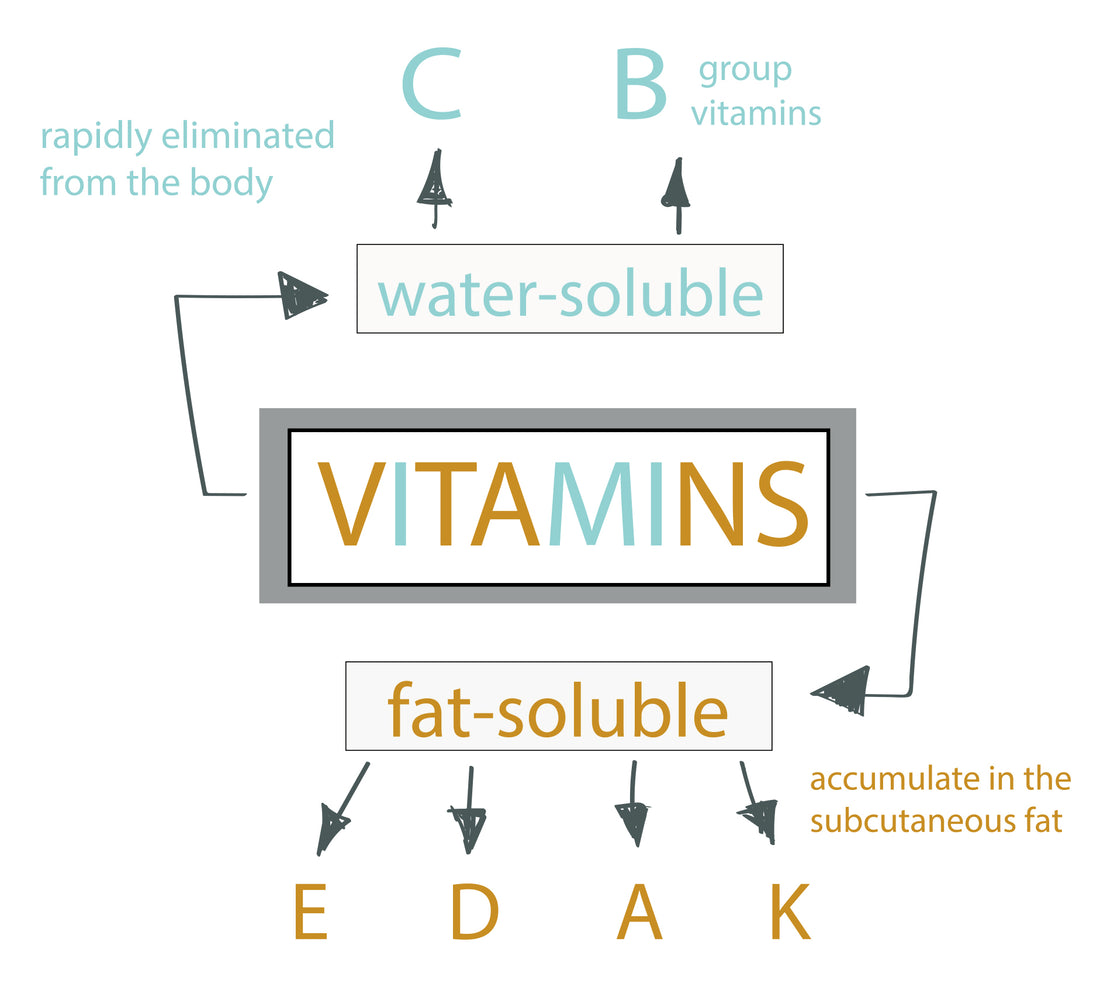Written by Antonio Reyes RDN
Water-soluble vitamins dissolve in water and are very important helpers in body metabolism, this means they aid in the correct breakdown of food, any deficiency or toxicity of these vitamins will likely diminish our over body metabolism.
Unlike fat-soluble vitamins, water-soluble vitamins are NOT stored in the body, they excreted.
There are 9 water-soluble vitamins, vitamin C and 8 different vitamins that are called “Vitamin B Complex” (B1, B2, B3, B5, B6, B8, B9, and B12). We are going to cover this chapter in two parts for a better understanding.
Vitamin C (Ascorbic Acid)
Vitamin C role in the body includes immune responses, wound healing and increase iron absorption when taking it together with a rich iron animal source like red meat, it is also an electron donor (antioxidant), and probably all of its biochemical roles the latter is the best known, nevertheless, the potentially protective role of vitamin C against colds is a term of debate in modern Medicine and Nutrition, since its “anti-flu” properties seems to be relevant only when taking it with Zinc (mineral).
Best Sources: tomato, orange, tangerine, guava, strawberries, pineapple and kiwi.

Special Note: One key aspect of vitamin C relays in its structure, being an antioxidant is highly reactive with oxygen exposure, after only 5 minutes of squeezing an orange into a glass 99% of the vitamin C content will be lost, leaving only a juice full of fructose, that being said is important to acknowledge that in order to get the best of the Vitamin C in foods the best is to eat them fresh and at the moment
RDI: 75 – 90 mg
Deficiency
The main cause of vitamin deficiency is Scurvy, a disease that causes tiredness, inflammation of the gums, small spots on the skin of red and violet color, joint pain and poor wound healing.
Other symptoms include depression, inflammation, and bleeding gums and loosening or loss of teeth. People suffering from scurvy may also suffer from anemia. Without treatment, Scurvy is deadly.
Toxicity
Eating high doses or excessive supplementation of Vitamin C can cause a disorder that leads to elevated levels of iron in the body, blood transfusions are required to stabilize the person.
Vitamin B1 (Thiamine)
Thiamine helps to eliminate CO2, it’s essential for growth, regulation of appetite, digestion, and healthy nerves, in body metabolism, it has an important role in the metabolism of carbohydrates and branched-chain amino acids, therefore a deficiency or toxicity can alter the way we digest carbohydrates and proteins.
Best Sources: liver, beans, soy, and potatoes.

RDI: 1 – 2 mg
Deficiency
An array of diseases can arise with Thiamine deficiency, more likely Wet Beriberi, a condition that affects the cardiovascular system, symptoms include shortness of breath, increased heart rate and swelling of the lower extremities.
Thiamine deficiency is extremely rare in the United States, nevertheless, it remains relatively common in many countries in Africa due to famines.
Toxicity
Thiamine is remarkably well tolerated within the human body even at intravenous doses that triple the requirements. Excessive oral supplementation is rapidly excreted in the urine.
Vitamin B2 (Riboflavin)
Riboflavin aids in the gas exchange (carbon dioxide and oxygen) of tissues, meaning that tissues can breathe and repair properly, it is also a transporter and helper of many key molecules to produce energy.
Best Sources: eggs, milk and green leafs vegetables.

RDI: 1.1 – 1.3 mg
Deficiency
Abnormal vascularization in the eye, lesions in the corners of the mouth, seborrheic dermatitis (squamous areas and red skin, particularly in the scalp, sore throat, hair loss, liver disorders, and nervous system problems. Severe long-term Riboflavin deficiency causes a shortage of red blood cells (anemia), which causes weakness and tiredness.
Toxicity
It has no evident toxicity, there are several protective mechanisms that prevent a raise of this vitamin in blood, and even at intravenous administration, it does not increase its concentration.
Vitamin B3 (Niacin)
Like many other vitamins, Niacin helps in a key step in the metabolism of carbohydrates, amino acids, lipids, tissue respiration (gas exchange) and the synthesis of very important molecules in the preservation of energy called NAM and NAD.
Best Sources: fish, liver, beef, poultry, and eggs.

RDI: 14 - 16 mg
Deficiency
Pellagra a disease that produces rough skin, appearance of skin blemishes, digestive and nervous disturbances.
Toxicity
Increased blood glucose level, liver damage, peptic ulcer and rash, even normal doses may be associated with a sensation of heat, redness, itching or tingling in the face, neck, arms or upper chest.
REFERENCES
-
Levine M. New concepts in the biology and biochemistry of ascorbic acid. New England Journal of Medicine, 1986.
-
Seddon JM et al. Dietary carotenoids, vitamins A, C, and E, and advanced age-related macular degeneration. Journal of the American Medical Association, 1994.
-
Sauberlich HE et al. Thiamin requirement of the adult human. American Journal of Clinical Nutrition, 1979.
-
Anderson SH, Charles TJ, Nicol AD. Thiamine deficiency at a district general hospital: report of five cases. Quarterly Journal of Medicine, 1985.
-
McCormick DB. Riboflavin. In: Shils ME, Olson JA, Shike M, eds. Modern nutrition in health and disease, 8th ed. Philadelphia, PA, Lea & Febiger, 1994.
-
Smith MD. A rapid method for determination of riboflavin in urine by high-performance liquid chromatography. Journal of Chromatography, 1980.
-
McCormick DB. Niacin. In: Shils ME, Young VR, eds. Modern nutrition in health and disease, 6th ed. Philadelphia, PA, Lea & Febiger, 1988.
-
Ribaya-Mercado JD et al. Effect of niacin status on gastrointestinal function and serum lipids [abstract]. FASEB Journal, 1997.


2 comments
fCydwPnBEHMsSGR
TJPNycCEQWzUSrB